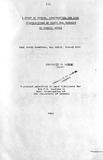| dc.description.abstract | The application of fanya juu terraces for soil and
water conservation in high and low rainfall areas is on the
increase, Fanya juu terraces have become popular because
they are easy to construct, less infertile subsoil is
exposed during the construction and when compared to bench
terraces, less labour is required for construction. But
for fanya juu terraces to be effective, proper design, bank
stabilization and maintenance are necessary.
The study of design, construction and stabilization
of.fanya juu terraces was carried out at the University
of Nairobi's Faculty of Agriculture Farm at Kabete, Kenya.
between 18-10.82 and 18-1-83 on nitosol soils. The·
suitability of the design of fanya juu terraces for retaining
maximum runoff expected in specified period of time put
forward by Thomas et al (1980) was studied. Labour required
for the construction and land taken up by terraces were also
studied. Seven grass species were planted on the banks of
the constructed terraces. These species were visually
evaluated for establishment and ground cover at the end of
the project. Stone wall was the control.
From the study, it was observed that the expression
formulated by Thomas et al (1980) give8 a good guidance for
designing fanya juu terraces. But data on infiltration and
rainfall intensity is necessary. If the construction of
fanya juu terraces is phased over a period of time, the
labour requirement can be within the capabilities of small
scale farmers. Average land lost from crop production in
(i x l
construction of fanya juu terraces was found to be 15%.
If this area is used for bana grass production - a species
which was observed to be high herbage yielder, about
45 t/ha green fodder can be obtained. This can be fed to
livestock. Bank protection, stabilization and maintenance
were observed to be necessary for fanya juu terraces. | en |

